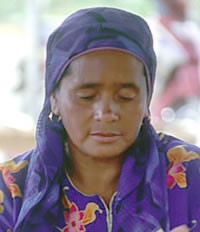Jama Mapun, Bajau Kagayan in Philippines

Photo Source:
Copyrighted © 2026
Peoples of the World Foundation All rights reserved. Used with permission |
Send Joshua Project a map of this people group.
|
| People Name: | Jama Mapun, Bajau Kagayan |
| Country: | Philippines |
| 10/40 Window: | No |
| Population: | 53,000 |
| World Population: | 71,000 |
| Primary Language: | Mapun |
| Primary Religion: | Islam |
| Christian Adherents: | 0.43 % |
| Evangelicals: | 0.43 % |
| Scripture: | New Testament |
| Ministry Resources: | Yes |
| Jesus Film: | Yes |
| Audio Recordings: | Yes |
| People Cluster: | Filipino, Muslim |
| Affinity Bloc: | Malay Peoples |
| Progress Level: |
|
Introduction / History
There are a number of inter-related tribes and peoples in Malaysia and the Philippines. One is the Jama, who are one of the Sama peoples. They are also related to the Bajau peoples. Jama groups are defined by their location. Those who live in Mapun, a Philippine municipality, are called the Jama Mapun. This is very near Malaysia, so it's no surprise they also live in that country. In Malaysia they are known as Sama Mapun. In the Philippines, most live in the southern islands where Islam is strong, but a small number live in Metro Manila.
What Are Their Lives Like?
Most of the Jama Mapun live in well-established villages with houses that are built on stilts. The villagers fish, mostly in all male crews, on a daily or overnight basis, returning to the village to eat and to sleep. Such settlements generally consist of densely clustered houses built in close association with the forests, where village members find seasonal employment cutting thatch or wood. Houses usually consist of a single room, raised on stilts one to two meters above the ground or high-water mark. Most have open porches or platforms on the front, which serve as common work areas. Kitchens are usually built on the back sides of the houses.
Each household has an acknowledged head, who is usually a man. He is the house owner and still actively engaged in making a living. Household spokesmen and other core members of the village cluster are often related. The most obvious ties are those of married sisters.
For many, fishing is the primary source of livelihood. Trade also occupies a central place in the Jama Mapun economy, and historically, they were highly valued for their specialized seafaring skills.
Except for nomadic groups of boat dwellers, fishing is carried out by all male crews, with women and children involved in inshore gathering. Male occupations include blacksmiths, boat builders, and inter-island merchants. Women often market pottery or work as weavers. Both men and women participate in the farm work.
The Jama Mapun have traditional music and dancing. They are especially fond of the Agal-Agal Festival, held every September 25th. It highlights their seaweed industry, but it's also a time to showcase their culture through a parade of floats.
What Are Their Beliefs?
The Jama Mapun first became Muslims because of the influence of Arab traders whom they recognized as being part of an advanced culture. They are Sunni Muslims of the Shafiite branch. Claims to religious piety and learning are an important source of individual prestige, and salip (descendants of Mohammed) are shown special honor. Variations of Islamic practices are associated with the relative status of different groups.
Every parish is served by a set of mosque officials. These include an imam, who leads members in prayer; a bilal, who performs the call to prayer; and a hatib, who gives the Friday mosque reading.
What Are Their Needs?
Few Christian resources are available for the Jama Mapun. They need Christ followers to take the gospel to their communities.
Prayer Points
Ask the Lord of the harvest to send forth faithful laborers to work among the Bajau Kagayan.
Ask the Lord to soften their hearts so that they will be receptive to the gospel.
Pray for the effective use of the JESUS Film among the Bajau Kagayan.
Ask the Lord to establish local churches that will plant more churches among the Jama Mapun.